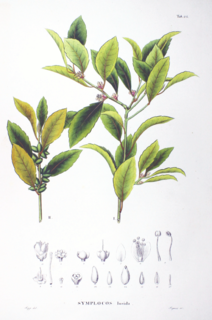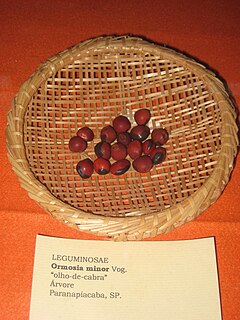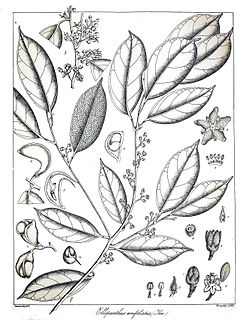
Clethra is a genus of flowering shrubs or small trees described as a genus by Linnaeus in 1753.

Hydnocarpus is a genus of medium to large trees in the Family Achariaceae; the genus was previously placed in the now defunct family Flacourtiaceae. Species have been recorded from Indochina, Indonesia, Malaysia and the Philippines.

Symplocos is a genus of flowering plants in the order Ericales. It contains about 300 species distributed in Asia and the Americas. Many species grow in humid tropical regions. This is sometimes considered to be the only genus in family Symplocaceae. Plants in this family are shrubs and trees with white or yellow flowers.

Ormosia is a genus of legumes. The more than 100 living species, mostly trees or large shrubs, are distributed throughout the tropical regions of the world, some extending into temperate zones, especially in East Asia. A few species are threatened by habitat destruction, while the Hainan Ormosia is probably extinct already.

Helicia is a genus of 110 species of trees and shrubs, constituting part of the plant family Proteaceae. They grow naturally in rainforests throughout tropical South and Southeast Asia, including India, Sri Lanka, Indochina, Peninsular Malaysia to New Guinea and as far south as New South Wales.
Heliciopsis is a genus of about thirteen species of trees, constituting part of the flowering plant family Proteaceae. They grow naturally in Burma, Indo-China, SE. China, Thailand, Peninsular Malaysia, Borneo, Sumatra, Java (Indonesia) and the Philippines. The name means similar to the plant genus Helicia. Its closest relatives are Athertonia (Australia) and Virotia.

Saurauia is a genus of plants in the family Actinidiaceae. It comprises about over 300 species distributed in the tropics and subtropics of Asia and South and Central America. Genetic evidence and the cell biology of the group support monophyly of the genus. Monophyly of the genus is also supported by micromorphological characters and by phylogenetic analysis, although the exact evolutionary relationships of Saurauia with the other two genera of the Actinidiaceae, Actinidia and Clematoclethra, are not well understood. It is also the only extant genus within its family whose natural distribution includes areas outside of Asia.

Ziziphus obtusifolia is a species of flowering plant in the buckthorn family known by several common names, including lotebush, graythorn, gumdrop tree, and Texas buckthorn.
Helicia pterygota is a plant in the family Proteaceae. It grows as a shrub or small tree up to 7 metres (20 ft) tall, with a stem diameter of up to 6 centimetres (2 in). The bark is brownish. The specific epithet pterygota is from the Greek meaning "winged", referring to the pedicel. Habitat is forests from 1,000 metres (3,300 ft) to 1,800 metres (6,000 ft) altitude. H. pterygota is endemic to Borneo where it is confined to Mount Kinabalu in Sabah.
Heliciopsis velutina is a species of trees, in the family Proteaceae. They grow up to 25 metres (80 ft) tall, with a trunk diameter of up to 25 cm (10 in). The bark is dark brown. They have reddish brown flowers. They have brown, ellipsoid fruits up to 4 cm (2 in) long. The specific epithet velutina comes from the Latin meaning "velvety", referring to the petiole. They grow naturally in lowland mixed dipterocarp forests' habitats from sea level to 600 metres (2,000 ft) altitude in Peninsular Malaysia and Borneo.
Canarium acutifolium is a forest tree species, of the plant family Burseraceae, growing naturally in New Guinea, the Moluccas, Sulawesi, New Britain, New Ireland, Bougainville and in lowland north-eastern Queensland, Australia.
Diospyros curranii is a tree in the family Ebenaceae. It grows up to 30 metres (100 ft) tall. The fruits are roundish, up to 2.5 cm (1 in) in diameter. Habitat is mixed dipterocarp forests from sea-level to 900 metres (3,000 ft) altitude. D. curranii is found in Indochina and from west Malesia to the Philippines.
Clethra longispicata is a tree in the family Clethraceae. The specific epithet longispicata is from the Latin meaning "long spike", referring to the inflorescence.
Clethra pachyphylla is a tree in the family Clethraceae. The specific epithet pachyphylla is from the Greek meaning "thick leaves".

Connarus is a genus of plants in the family Connaraceae.
Connarus agamae is a tree in the family Connaraceae. It is named for José Agama, a former Deputy Conservator of Forests in British North Borneo.

Ellipanthus is a genus of plants in the family Connaraceae. The generic name is from the Greek meaning "defective flower", referring to the incomplete development of some of the stamens.
Melicope confusa is a tree in the family Rutaceae.
Glycosmis macrantha is a tree of Borneo in the family Rutaceae. The specific epithet macrantha is from the Greek meaning "large flower".
Elaeocarpus stipularis is a tree in the Elaeocarpaceae family. It is found from the Aru Islands, eastern Indonesia, to Philippines, and through Mainland Southeast Asia to Odisha, India. It has edible fruit, its wood is used and some medical uses are ascribed to it.








